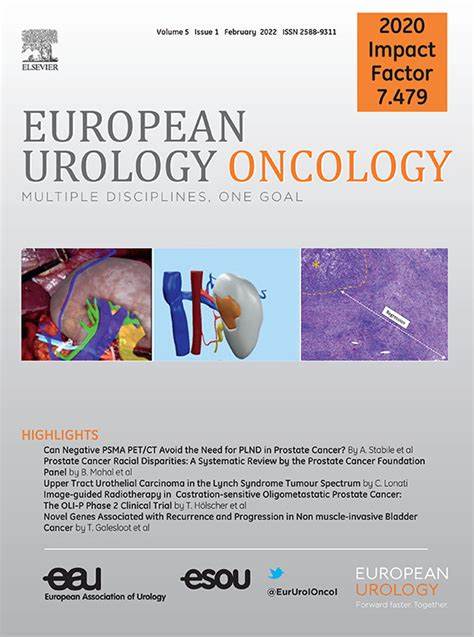筛查轮次之间的前列腺癌检测:来自STHLM3-MRI试验的证据。
IF 9.3
1区 医学
Q1 ONCOLOGY
引用次数: 0
摘要
背景和目的:STHLM3-MRI邀请筛查试验发现,与系统活检相比,基于磁共振成像(MRI)的前列腺癌(PCa)筛查提高了早期发现。本研究的目的是描述STHLM3-MRI试验筛查轮之间的检测和PCa发病率。方法:研究人群包括50-74岁的男性,在STHLM3-MRI试验的MRI(实验)组中,第一轮未诊断出PCa。我们定义了三个风险组:低风险(基线前列腺特异性抗原[PSA])。主要发现和局限性:在7256名男性的研究人群中,33%至少进行了一次PSA检测,2.2%进行了MRI检查,0.8%进行了活检,0.3%诊断为PCa, 0.2% (n = 17)在筛查轮次之间患有国际泌尿外科病理学会分级组≥2 PCa。按风险分层,27%、40%和54%的低风险(n = 5009)、非高风险(n = 1200)和高风险(n = 1047)的男性分别进行了PSA检测。PCa的检出率较低,但随着风险水平的增加而增加,低风险为0.1%,无升高风险为0.3%,升高风险为1.4%。这些结果是瑞典特有的,取决于筛查轮之间的间隔时间。结论和临床意义:我们观察到STHLM3-MRI筛查之间的检测率为33%,但在风险较低的男性中检测到的PCa病例很少。大多数癌症都是在高危人群中诊断出来的。减少低风险人群的机会性检测对于优化未来筛查规划的效益至关重要。本文章由计算机程序翻译,如有差异,请以英文原文为准。
Prostate Cancer Testing Between Screening Rounds: Evidence from the STHLM3-MRI Trial
Background and objective
The STHLM3-MRI screening-by-invitation trial found that magnetic resonance imaging (MRI)-based screening for prostate cancer (PCa) improved early detection in comparison to systematic biopsy. The aim of the present study was to describe testing and PCa incidence between screening rounds of the STHLM3-MRI trial.
Methods
The study population comprised men aged 50–74 yr in the MRI (experimental) arm of the STHLM3-MRI trial without a PCa diagnosis in the first round. We defined three risk groups: low risk (baseline prostate-specific antigen [PSA] <1.5 ng/ml; not invited to the second round after 2–3 yr); non-elevated risk (1.5 ≤PSA <3 ng/ml and Stockholm3 score <11%); and elevated risk (PSA ≥3 ng/ml or Stockholm3 score ≥11%). Interval events included PSA tests, MRI examinations, biopsies, and PCa detection.
Key findings and limitations
In the study population of 7256 men, 33% had at least one PSA test, 2.2% had an MRI examination, 0.8% had a biopsy, 0.3% had a PCa diagnosis, and 0.2% (n = 17) had International Society of Urological Pathology grade group ≥2 PCa between screening rounds. Stratified by risk, 27%, 40%, and 54% of men with low risk (n = 5009), non-elevated risk (n = 1200), and elevated risk (n = 1047), respectively, had a PSA test. The PCa detection rate was low but increased with risk level, at 0.1% for low risk, 0.3% for non-elevated risk, and 1.4% for elevated risk. These results are specific to Sweden and depend on the interval length between screening rounds.
Conclusions and clinical implications
We observed a substantial testing rate of 33% between STHLM3-MRI screening rounds, but few PCa cases were detected among men with lower risk. Most cancers were diagnosed in the elevated-risk group. A reduction in opportunistic testing in lower-risk groups will be crucial for optimising the benefits of future screening programmes.
求助全文
通过发布文献求助,成功后即可免费获取论文全文。
去求助
来源期刊

European urology oncology
Multiple-
CiteScore
15.50
自引率
2.40%
发文量
128
审稿时长
20 days
期刊介绍:
Journal Name: European Urology Oncology
Affiliation: Official Journal of the European Association of Urology
Focus:
First official publication of the EAU fully devoted to the study of genitourinary malignancies
Aims to deliver high-quality research
Content:
Includes original articles, opinion piece editorials, and invited reviews
Covers clinical, basic, and translational research
Publication Frequency: Six times a year in electronic format
 求助内容:
求助内容: 应助结果提醒方式:
应助结果提醒方式:


